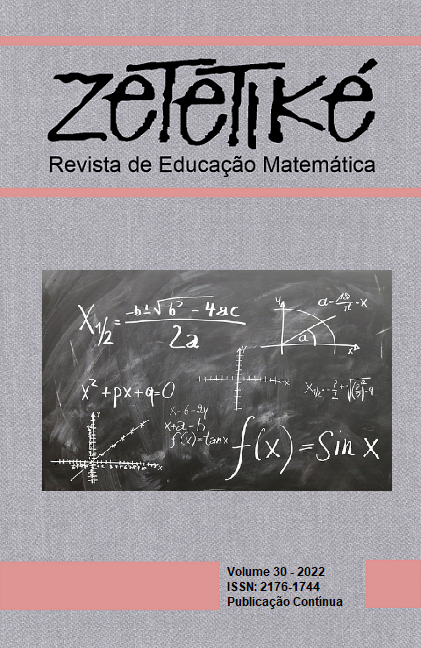Abstract
This article is an excerpt from an investigation carried out in a classroom in the 7th year of teaching elementary school in a state public school in the countryside of São Paulo. It is an investigation of the own practice, with a qualitative approach, which is supported by the cultural historical psychology and studies of Luis Radford for the discussion of the elaboration of algebraic thinking. The purpose of this text is to analyze the evidence of the process of producing meanings with the use of different semiotic systems for the representation of algebraic thinking. Lessons were videotaped based on the resolution of problems, focusing on the construction of algebraic generalizations, from the observation of symbolic-numeric sequences. The analysis of an interactive episode that occurred during the synthesis of the students' productions involving one of the proposed problems revealed signs of significance for the use of formal algebraic language.
References
Brizuela, B. M., & Earnest, D. (2008). Multiple notational systems and algebraic understandings: the case of best deal problem. In J. J. Kaput, D. W. Carraher & M. L. Blanton, Algebra in the early grades (1a ed., pp. 276-301). Lawrence Erlbaum Associates.
Fontana, R., & Cruz, N. (1997). Psicologia e trabalho pedagógico. Atual Editora.
Góes, M. C. R. (2000). A abordagem microgenética na matriz histórico-cultural: uma perspectiva para o estudo da constituição da subjetividade. Caderno Cedes, (20)50, 9-25.
Kant, I. (1929). Critique of Pure Reason (Traduzido por Norman Kemp Smith das edições de 1781 e 1787). Nova Iorque: Editora St. Marin. 2ª impressão, 1965.
Pereira, J. T. G. (2019) O desenvolvimento do pensamento algébrico: significações produzidas por alunos do sétimo ano do Ensino Fundamental (Dissertação de Mestrado). Universidade São Francisco, Itatiba, Brasil
Radford, L. (2006a). Algebraic thinking and the generalization of patterns: a semiotic perspective. 28th Conference of the International Group for the Psychology of Mathematics Education, Bergen. (v. 1, pp. 2-21). Mérida: Universidad Pedagógica Nacional.
Radford, L. (2006b). Elementos de una teoría cultural de la objetivación. Relime, n. especial, 103-129.
Radford, L. (2007) Iconicity and contraction: a semiotic investigation of forms of algebraic generalizations of patterns in different contexts. ZDM, 40(1), 01-14.
Radford, L. (2000). Signs and meanings in students’ emergent algebraic thinking: A semiotic analysis. Educational Studies in Mathematics, 42, 237-268.
Ribeiro, A. J., & Cury, H. N. (2015). A álgebra, seu ensino e sua
aprendizagem. In A. J. Ribeiro & H. N. Cury, Álgebra para a formação do professor: explorando os conceitos de equação e de função (pp. 11-27). Autêntica Editora.
São Paulo (Estado) (2014). Secretaria da Educação. Caderno do aluno: 6ª série/7° ano - Matemática. São Paulo.
Smith, M. S., & Stein, M. K. (2012). 5 practices for orchestrating productive mathematics discussions. The National Council of Teachers of Mathematics.
Smolka, A. L. B. (2004). Sobre significação e sentido: uma contribuição à proposta de rede de significações. In M. C. R. Ferreira, K. S. Amorim, A. P. S. Silva & A. M. A. Carvalho (Orgs.), A rede de significações e o estudo do desenvolvimento humano (pp. 42-59). Penso.
Van de Walle, J. (2009). Matemática do ensino fundamental: formação de professores e aplicação em sala de aula (6.ª ed., Paulo Henrique Colonese, Trad.). Artmed.
Vigotski, L. S. (2001). A construção do pensamento e da linguagem (Paulo Bezerra, Trad.). Martins Fontes.

This work is licensed under a Creative Commons Attribution-NonCommercial-NoDerivatives 4.0 International License.
Copyright (c) 2022 Zetetiké


